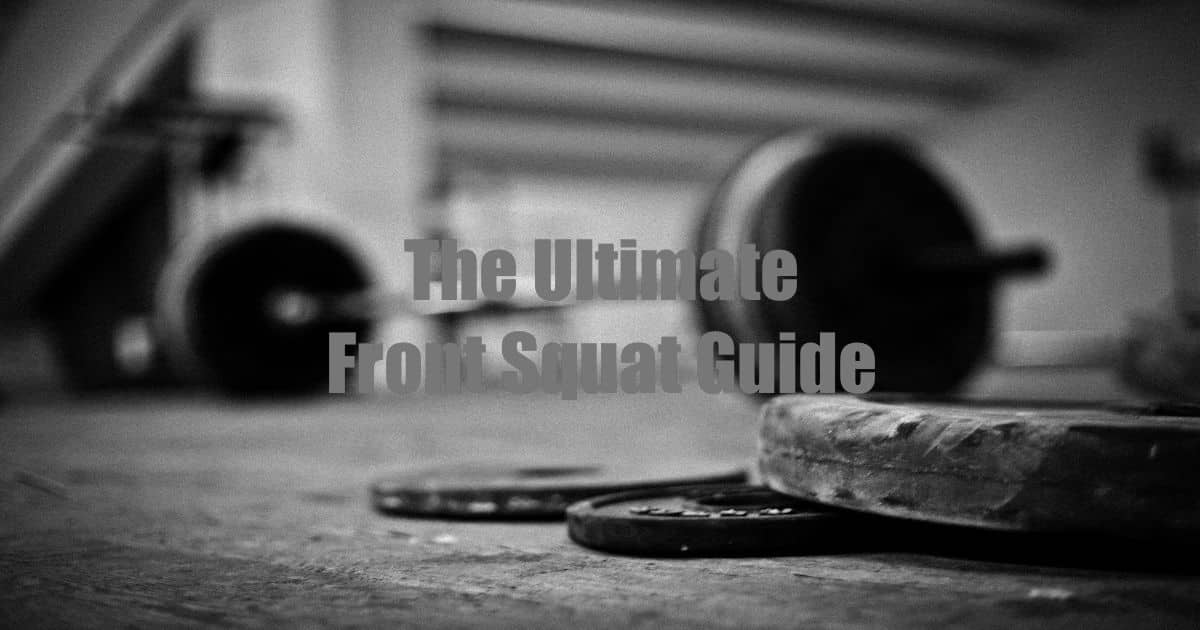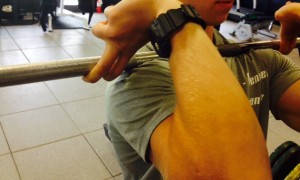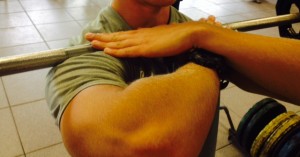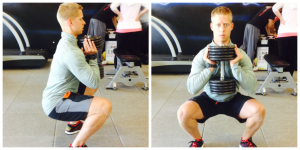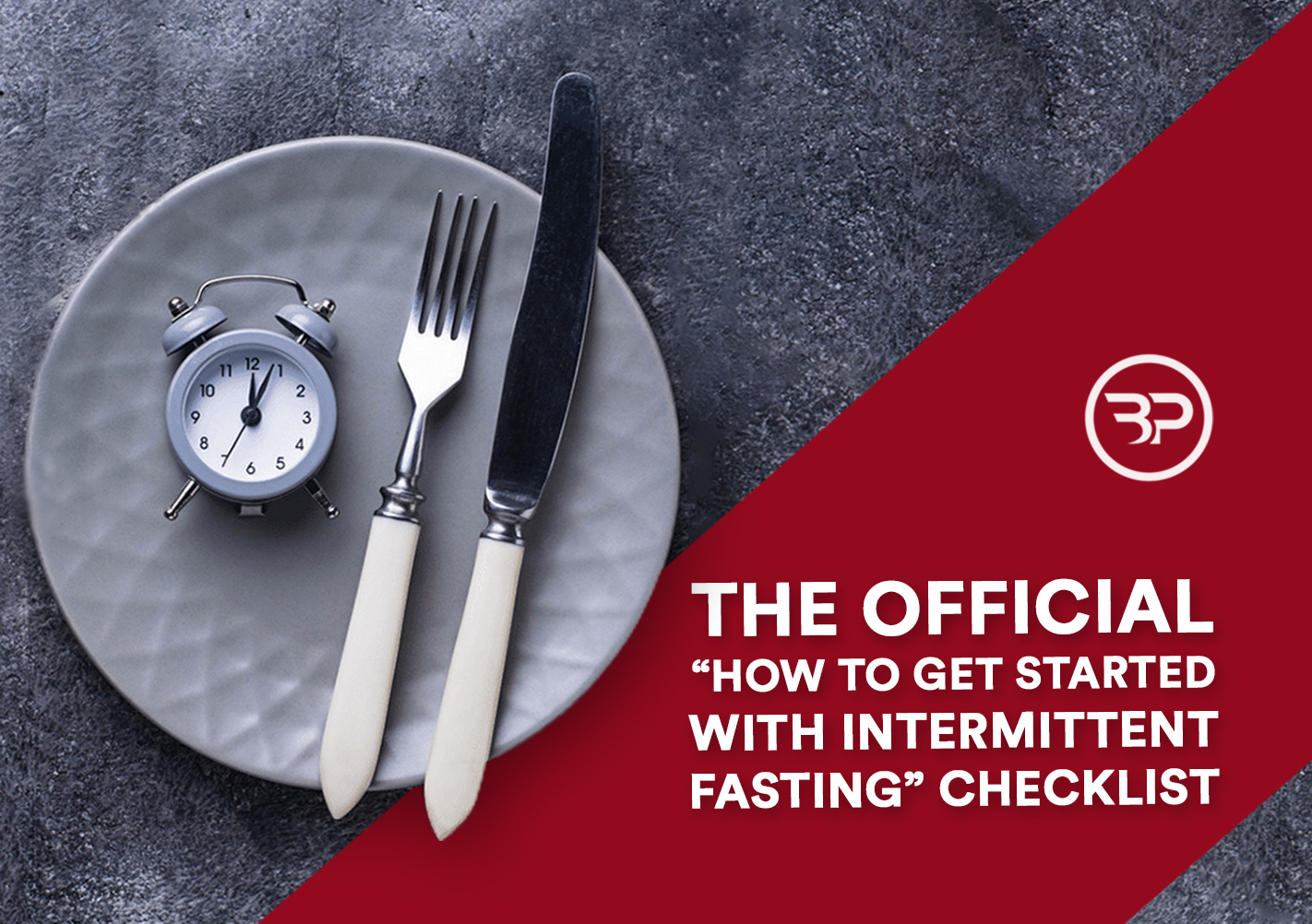How To Front Squat To Build Muscle And Look Great Naked
June 11, 2014
Before diving into the front squat thank you for being here. This is one of our most popular articles of all time. It’s a thick read, but we’ve developed a guide for you called the Chiseled Muscle Cheatsheet Grab it here. Thanks and enjoy the article.
-Eric
When you hear about the ultimate lift for an explosive lower body and huge squat numbers most are referring to back squats.
It’s the most popular squat variation around and part of the big three in powerlifting.
Word on the street is a big back squat is what helps James Bond stay at it after all these years. The Bond rumor may or may not be true but the fact is this: The back squat is arguably the best lift you can do to get stronger, more athletic, and look better naked.
Or is it?
The way I see it, the front squat is the best lift you’re not doing and a better choice than the back squat for most people. By the end of the article, you’ll be able to judge for yourself. Either way, one thing is clear: the squat movement pattern is required if you want to be strong, athletic, and look great naked without living in the gym.
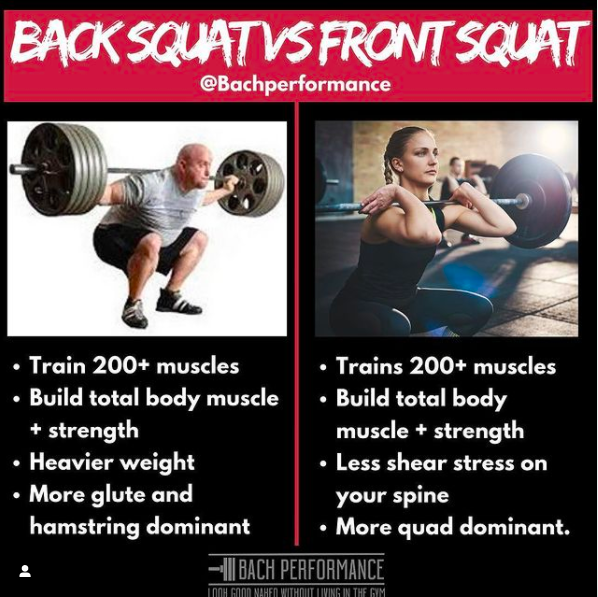
The Front Squat is the Real King for complete strength
For starters, front squats require hard work, which most gym-goers avoided like the bubonic plague, opting to post every gym P.R. and dozens of half-naked selfies on Instagram. This startling trend combined with lifters staying content with their classic leg presses and smith machine squats has led to anemic leg development, un-balanced physiques, and movement patterns ripe with dysfunction. Wasting time with ineffective training is the poison. Doing less, but better, with some squats mixed in is the antidote.
Why you need to front squat
- Increase depth achieved and glute activation: Anterior placement of the barbell allows greater depth during front squats. Muscle activation of the gluteus maximus also increases with increased hip flexion (squat depth), and the subsequent concentric action of hip extension. [Caterisano et al]. This means potentially better booty gains.
- Improve core strength: Anterior bar placement keeps the torso vertical, preventing the hips from going into an excessive anterior pelvic tilt, and requiring greater oblique and rectus abdominus involvement to prevent flexion. A stronger anterior core can prevent flexion-based injuries to keep you training longer and harder.
- Huge Quad Development: Deeper knee flexion from greater depth during the eccentric a more upright posture, and narrower stance all lead to greater knee extension during the concentric and thus huge quad development.
- Decreased lumbar and knee stress: Anterior bar placement forces lifters to attain an upright posture, decreasing shear stress on the spine. Gullet et al found significantly lower compressive forces at the knee compared to back squats without compromising muscle activity in the quads or hamstrings.If you have a history of meniscal injuries and your knees sound like firecrackers front squats are a great option due to lighter loads being lifted compared to back squat. This means potentially more gains with less pain. This guide will help with knee pain as well ;).
- Front Squats Increase your Power Clean: Whether you’re a competitive athlete, weekend warrior, or want to look better naked Olympic lifts are a valuable tool. Stronger hip extension, stronger anterior core, and a direct transfer to the “catch” phase of cleans illustrate why front squats aid in developing the power clean. There’s a reason front squats have been an Olympic lifting mainstay for decades—they work.
- Increased Thoracic Extension and a Stronger Upper Back: Let’s be real here—Most dudes have the posture of Smeagol from the Lord of the Rings Trilogy. In the interest of getting laid, appearing confident, or improving performance Smeagol posture is bad news.Front squats require scapula and clavicle elevation and upward rotation to keep the elbows up and the bar in the proper position. This requires the traps, serratus anterior, levator scapulae, rhomboids, and lats to work in conjunction to hold position and prevent you from dumping the bar forward.
I’ve had dozens of clients improve posture, mobility, and strength of the thoracic extenders with front squats. Being able to maintain thoracic extension will aid your deadlift too.
- Total Body Mobility and Stability: Front squats require significant mobility and stability in the hips, knees, ankles, and shoulder—something everyone in today’s “sit-in the office, go home and play XBOX” society needs. Increased mobility requirements and maintaining position under load will pour concrete over the greater movement foundation.
- Total Body Strength Gains: Regardless of your goal improved strength will increase your success. Building strong quads, a strong, resilient anterior core, glutes, and explosive hip extension will improve all other training qualities in the gym.
- Increased Muscle Mass: Squats are widely considered the “king of hypertrophy”. They’re a vital piece in mass building due to hormonal adaptations from progressive overload and total body training stimulus.Anecdotal evidence from Olympic weightlifters, bodybuilders, and personal experience make one thing perfectly clear—Front squats build massive quads and a thick upper back.
With all of these kick-ass benefits, it’s a no-brainer that front squats deserve your attention.
[P.S. Don’t forget your free progression cheatsheet and front squat specialization workout. Get them here.]
The Biomechanics of the front squat: A How-To Guide
Front squats and back squats are quite similar: They require total body strength, stability, and power through hip and knee extension and flexion, dorsiflexion of the ankles, and a rigid core to resist flexion and folding like a napkin under the bar. Despite these similarities, there are significant differences; most notably, anterior bar position during the front squat.
This change in bar position alters the center of mass and places a greater emphasis on the quadriceps, upper back, and supporting muscles of the trunk.
The spine stays more vertical, lengthens the lats, reduces shear stress on the spine, and requires additional core involvement to keep you vertical.
This keeps the lower back tight by default—lumbar flexion and learning forward “dump” the bar before excessive flexion takes place. This built-in safety mechanism teaches proper abdominal bracing, posture, and overcoming a significant load when first learning how to front squat.
“Are front Squats worse for my knees?”
Well, not necessarily.
Research in the Journal of Strength & Conditioning by Gullet et al compared the biomechanics of the front squat and the back squat. The front squat and back squat elicited very similar muscle activation despite the front squat weight being 70% of the back squat load.
The back squat had more compression on the spine and knees (due to larger loads in my estimation), with greater torque in the knees. So, overall muscle activation was the same with a lower load, less compressive joint stress to the knees and back, and less shear stress than front squats.
This backs up my experiences as an athlete and coach—you’re less likely to be injured during a front squat than a back squat. All things considered, achieving a comparable training effect with less external loading and joint stress is a good thing.
From an anatomical standpoint arguably every muscle plays a role in the front squat. But, due to the brevity of our attention span, we’ll leave it at these: the quadriceps, gluteus maximus, adductor magnus, soleus, hamstrings, gastrocnemius, erector spinae, anterior/lateral deltoids, supraspinatus, rhomboids, upper/middle/lower traps, levator scapulae, serratus anterior, rectus abdominus, and obliques are all needed to stabilize the load and complete the lift.
Muscles are an integrated system that must work together to produce efficient movement, few exercises work as many of them together as front squats. Let’s find out how to front squat some damn weight!
How to front squat: Master the fundamentals
Watching Youtube videos isn’t enough to learn how to Front Squat –you actually need to master the component pieces and get under the bar.
Grip: There are multiple ways to grip the front squat, but the “clean” grip is the best option. The clean grip involves wrapping your fingers around the bar and keeping the elbows up and in. This trains the catch position of the clean and provides maximum control barbell.
As few as two fingers wrapped around the bar is acceptable when the elbows are elevated. Unfortunately, it’s difficult for many lifters to get in proper position when learning how to front squat. In this case, regress the grip and work on flexibility.
Clean Grip with straps: This grip is similar to the clean grip but uses straps to hold onto the bar when there are mobility restrictions with the regular clean grip. This is a great grip to use while improving mobility and working towards a clean grip. Christian Thibaudeau shows you how below.
Bodybuilding Grip: The bodybuilding grip involves resting the bar on the top of the shoulders with hands over the bar and elbows kept high. This is great for beefcakes with the mobility of a fork, but it sucks for controlling the barbell and for athletes. Use this grip as a last resort when severe mobility or wrist limitations are present.
Set the Bar against the neck: There’s no denying it—getting the bar in proper position sucks. Racking a loaded barbell against your throat and performing squats gets you out of your comfort zone and builds toughness. (I heard front squats give you big cajones or something).
Once you select your grip, the barbell must stay against the base of the neck with the chin tilted up to keep the joints stacked and bar close to the torso. Failing to do so allows your elbows to drop, the bar to crash, and you peeling your tattered carcass off the floor.
Elbows Up and In It’s Simple— Force the “elbows up” during the entire front squat and you’ll be in good shape. Failing to drive the elbows will result in a loss of spinal position, kyphotic posture, and dumping the bar forward during the squat.
Abs Braced and Breath: Front squats create a “lengthening” of the core when the elbows are elevated. Use the anterior core to create stability by bracing and staying neutral in the trunk rather than arching. Proper breathing and pulling air into your gut becomes increasingly important during front squats as the Valsalva maneuver increases intra-abdominal pressure to provide an internal belt of support to prevent injury and improve strength.
Breathe into your stomach and brace like you’re taking a punch from Mike Tyson after stealing his tiger. If that doesn’t work, here’s a great video on the abdominal brace by Chris Duffin. Gather as much air as possible before descending into the squat—you’ll need it.
Walkout: Grip the bar, drive the elbows high, brace the abs, and squat the bar out.
Left foot out.
Right foot out.
Re-settle, breath, and go. The front squat is a different animal than your typical squat; keep the feet closer to shoulder width with very slight toe flair.
Execution: After the walkout gather your air, sit back slightly, and break at the knees and hips simultaneously while driving the elbows high. Keep a vertical spine and descend to the deepest depth possible without compromising spinal integrity—more on butt wink later.
Hold your air as long as possible, drive the elbows up, and stand up until the hips are fully extended. Exhale and walk the bar all the way into the rack, push against the safety hooks and squat the weight down—no sloppy split-stance bar dumping allowed.
Front Squat Depth: why it matters to you
The anterior load of the front squat and increase in anterior core activation allows for a deeper squat without compromising spinal position and risking injury. Unfortunately, butt wink still occurs. Sub-parallel squats aren’t for everyone, bony hip anatomy, anterior core weakness, and posterior chain weakness are frequent culprits that preventing an ass-too-grass squat.
Blasting heavy-ass squats with a curved lumbar spine is a recipe for acute injury and long-term dysfunction, regardless of what anyone says.
This should be avoided with mobility and stability being trained until further depth is achieved without compromising spinal position. Mobility and stability will improve with increased front squatting and time—stop slamming square pegs into round holes because bro-science says “ass-to-grass squats or you’re a sissy. ”
P.S. Bret Contreras does a great job of explaining Butt-wink here, I highly recommend you check it out.
How to Front Squat: Common Issues and Cues
1.) Elbows Drop: Failure to keep the elbows high is the result of mobility restrictions, being lazy as poo on a hot summer day, or weakness in your upper back.
It becomes exponentially more difficult to keep the elbows up after 5-6 heavy reps on front squats; keep reps lower and increase submaximal training for practice. Avoid excessively arching the low back into lumber hyperextension for elbow position; instead, build a stronger core and improved thoracic mobility with this drill from Eric Cressey.
2.) Chest Caves: This happens because the elbows dropped (see below) or improper set-up. Ensure the barbell is against the base of the neck and the elbows are kept high during the entire set to maintain posture and bar position.
3.) Falling Forward: The anterior load is pulling you forward, you need to get the hips back slightly at the initial descent (pop that booty) and keep the elbows high. Drive the heels into the ground during the concentric portion of the exercise.
4.) Falling Backward: You’re sitting back too far. Every exercise is a tool—use it the way it’s meant to be trained. In this case, use a smaller hip hinge at the start of the squat and allow the quads and anterior core to do their job.
5.) Spread the floor to prevent Valgus collapse: Unless you’re a fan of grotesque knee injuries and months of rehab it’s best to avoid valgus collapse. Despite a few (slim few) elite powerlifters having great success with the knees diving on a back squat this technique is best avoided. Slightly push the knees out during the descent of front squats to maintain stacked joints.
6.) Grip: If the bar is misaligned imbalances will be referred down the kinetic chain. The clean grip gives the most control over the bar, use it. Peel a few fingers away from the bar, (as few as two fingers suffice with the clean grip) to gain control and take stress off of the wrists. Work on tissue quality and length in the forearms, wrists, and lats to improve comfort with the clean grip.
7.) Weak Anterior Core: If you’re weak in the anterior core you’re going to have a host of problems; specifically, maintaining vertical spine under load. Practice front squats multiple times during the week and add in a heavy dose of abdominal rollouts, planks, pallof presses, and farmer walks.
How Front Squats help you build massive muscle
Anecdotal evidence from bodybuilders and Olympic weightlifters shows us front squats are great for total body muscular development; specifically, massive quads and a thick upper back. Here are some additional muscle-building considerations:
- Greater Hip flexion and depth require greater hip extension and gluteus maximus recruitment on the concentric portion of the exercise– both important for greater gluteus maximus activation.As a side note it would be interesting to see where the trade-off ends in muscle activation between the increased squat depth (with a front squat), and increasing stance width and activation of the adductors and gluteus maximus in a wide, powerlifting squat.
Basically, because you squat deeper your glutes work harder and voila, a greater muscle-building stimulus. (Paoli et. Al)
- Front Squats build big quads due to anterior bar placement and high amounts of knee flexion.
- Keeping the elbows high forces the thoracic extenders to hold position, adding training volume to build your upper back.
- The front squat was shown to be as effective as the back squat in terms of overall muscle recruitment, with significantly less compressive forces on the knee. [Gullet et al] This becomes increasingly important with increased training age.
- Front squats should be done with a full range of motion, as they result in more thigh muscle growth with full reps than partial [McMahon et al].
- Training the quadriceps at long muscle lengths (greater knee flexion) results in higher muscle activation than training at shorter muscle lengths, finish your reps.
Front squats create massive strength gains
Say what you want, but anyone who front squats big weights will be damn strong, both in terms of relative strength and absolute strength.
Here are some additional strength-building considerations:
- Front squats require less relative load for similar muscle activation of the quads, glutes, and hamstrings while decreasing stress on the spine and knees compared to back squats. This screams less risk, more reward.
- Additional stress to the thoracic extenders is beneficial to all pulling movements: deadlifts, squats, rows, and pull-ups are all potentially improved.
- Huge anterior core training stimulus will improve carryover to other compound lifts.
- It’s a damn squat. If you squat heavy with good form and a well-designed plan you’ll get as strong as an ox.
Front Squats are Better for Athletes
Everything in the weight room is a tool; risk: reward analysis must be taken into account. I prefer front squats as my primary squatting method with athletes for the following reasons:
- Front squats are beneficial for those competing in weightlifting events because they’re an essential component in the execution of the clean. [Fry et al]. Many of my clients clean so this improves multiple factors a once.
- Anterior bar position means less shear stress on the spine and provides a more back-friendly alternative to back squats for older athletes, taller athletes, and lifters intolerant to shear stress.
- Squats mimic the biomechanical demands of athletic movements like the powerful hip extension needed for sprinting, jumping, tackling, and skating. Moreover, maintaining the abs braced, neutral spine position under load is vital for athletes to be maximally efficient and avoid “dumping” during movement.
- Front squats are a tool for potentiation and long-term improvements in acceleration and maximal sprint running. Performance is improved from performing squats (30%, 50%, and 70% 1 RM) as part of the athletes’ warm-up 4 minutes before sprint trials, leading to long-term benefits after sprint training by allowing the athlete’s neuromuscular system to perform at a higher level during each training session [Yetter et. Al]. Hell, even if you’re not an athlete it’s cool to be fast.
- Greater anterior core activation due to anterior bar placement. Having too much core strength is as likely as a snowball not melting in hell.
Similar muscle activation is achieved with front squats as back squats with a lighter load, leading to less compressive and shear stress on the knees and spine. The spine handles compression well—lumbar vertebrae are huge. Unfortunately, shear stress with compression is a recipe for injury and cranky backs.
How to Front Squat: The Ultimate Progression
It’s not a good idea to load an exercise without establishing stability through an acceptable range of motion and ironing home good technique. To learn how to front squat you need a progression– here it is.
BW Squat: From standing position push the hips back and break at the knees, descending with the hips until parallel is reached with the arms extended at shoulder height with the chest up. Extend the hip and knee to stand back up. Rinse and Repeat.
Goblet Squat: Grip a kettlebell or dumbbell underneath one end and hold at chest height. Keeping the chest tall and abs braced descend by breaking at the hip and knee until the proper depth is achieved. Extend the hip and knee, returning to a full stand.
Goblet Squat W/Pause: Grip a kettlebell or dumbbell underneath one end and hold at chest height. While keeping the chest tall and abs braced descend by breaking at the hip and knee until proper depth is achieved, pause while staying tight, and extend the hip and knee, returning to a full stand.
2 KB Front Squat: Hold two kettlebells at chest height and stand tall with the abs braced. Keep the kettlebells “up” while breaking at the hips and knees simultaneously until proper depth is achieved. Extend the hip and knee, return to a full standing position.
As a bonus, a 1 kettlebell front squat hits all the components above while adding anti-lateral flexion to the plethora of benefits.
2 KB Front Squat w/Pause: Holding one kettlebell in each hand at chest height stand tall and brace the core. Keep the kettlebells “up” while breaking at the hips and knees simultaneously until the proper depth is achieved and pausing without losing tension. Extend the hip and knee, returning to a full stand.
Bottoms Up Front Squat: The bottoms up front squat eliminates the stretch reflex and forces your legs and core to fire and stabilize your body before the legs initiate the lift from the pins.
Bar w/Pause: Using a clean grip (2 fingers only if necessary) break at the hips and knees simultaneously, keeping the abs braced and elbows up as you descend to depth. Pause while maintaining a “rigid” core, then stand up by fully extending the hip and knee.
Double Pause Front Squats:
If you’re weak out of the hole or tend to dump your front squats, double pause front squats are for you. The additional time under tension helps you build insane isometric strength to bust through your training plateaus.
There are many ways to “skin the cat” when it comes to squat progressions, but this technique has worked best for me when teaching novices how to front squat.
You combine anterior loading, torso rigidity, a lower-body training stimulus, and the ability to hold positions under load before moving onto the barbell.
Perform each rep with intent and gradually load as technique improves. Don’t worry– tell your ego you’ll be piling plates in no-time.
The Front Squat: Questions and Answers
Ask yourself—If your body can’t get into proper position under load should you be going there?
Unless you’re okay with piling strength on top of dysfunction and getting hurt, NO. The performance increase may be worth it for lifters trying to boost a total, but for athletes and general population using the front squat as a tool for performance rather than a mode of competition, it’s not worth it.
Should you Wear a Weight Belt for Front Squats?
When it comes to using a belt a few situations must be taken into account. Compared to deadlifts and back squats there is less shear stress due to a more vertical spine position. I coach my clients to brace their abs, negating the need for a belt in most cases.
If you’re powerlifting circumstances are different—you need to learn how to push your abs out and apply more force when lifting. Still, keep belts for the rare top-end set, not for your ugly-biceps curls and sub-maximal work. Dr. Stu McGill summarizes it perfectly here “Many people adopt belts in training for one of three reasons:
• they have observed others wearing them and have assumed that it will be a good idea for them to do so.
• Their backs are becoming sore and they believe that a back belt will help.
• They want to lift a few more pounds.
None of these reasons are consistent with the objective of good health. If you must lift a few more pounds, wear a belt. If you want to groove motor patterns to train for other athletic tasks that demand a stable torso, it is probably better not to wear one. Instead, do the work to perfect lifting technique.”
Front Squats and Lifting Shoes
For competitive lifters, I recommend an elevated heel for front squats. For Athletes and other lifters the choice is optional—if you need to improve ankle mobility to squat deep then lifting shoes are an option “hack” your depth, but is going to a position you’re body doesn’t achieve naturally worth the extra five pounds?
I’d recommend sticking within your limits and increasing your ankle mobility rather than using equipment as a crutch.
The Ultimate Front Squat Workout
Let’s be real here, you didn’t read all this to NOT get a sweet workout program. Download your front squat workout and bonus Chiseled Muscle Cheatsheet here.
This program will help you build significant strength, muscle, and improve your athleticism, unlike many routines you read in bodybuilder magazines and websites.
If you’re up to the challenge then you need to bring it to every workout. Each workout you’ll be training with a focus on either maximum strength, volume for hypertrophy, or speed for athleticism and additional gains in strength and muscle mass.
Front Squat Finisher
I’ve professed my love for furious finishers here. During one particularly creative (read: tormented) workout session I designed a finisher solely for front squats. This is a very advanced test of physical and mental grit. If you’re a good squatter, tough as nails, and without injury, give this a shot. Killer Front Squat Finisher.
The Final Word On Front Squats
Like any exercise a risk: reward analysis is necessary to determine what’s the best tool for the job. That said, the front squat is everything you need and then some to perform at your peak and look great naked in the process.
Everyone from bodybuilders, athletes, and weekend warriors benefit from decreasing joint stress, increasing total body training stimulus, and attacking common weak points like thoracic extension and the anterior core.
Leave your ego at the door and focus on your front squat— they’re likely the missing link to fixing your chicken legs, caveman posture, and finally building the body you deserve.
Resources:
Bach, Eric. “5 Plateau Busting Finishers.” Schwarzenegger.com. Schwarzenegger.com, 3 Mar. 2014. Web. 30 May 2014. <http://www.schwarzenegger.com/fitness/post/5-plateau-busting-finishers>.
Bach, Eric. “Killer Front Squat Finisher.” Elite FTS. Elitefts.net, 13 June 2013. Web. 30 May 2014. http://articles.elitefts.com/training-articles/killer-front-squat-finisher/
“Barbell Front Squat.” Barbell Front Squat. ExRx.net, n.d. Web. 30 May 2014. <http://www.exrx.net/WeightExercises/Quadriceps/BBFrontSquat.html>.
Breathing and Abdominal Bracing for Strength. Dir. Chris Duffin. youtube.com, 2013. Film.
Bench T-Spine Mobilizations. Dir. Eric Cressey. youtube.com, 2013. Film.
Caterisano, A., R.F. Moss, T.K. Pellin-ger, K. Woodruff, V.C. Lewis, W. Booth, and T. Khadra.The effect of back squat depth on the EMG activity of 4 superficial hip and thigh muscles.J. Strength Cond.Res. 16(3):428–432. 2002.
Contreras, Brett. “Bret Contreras.” Bret Contreras. Bretcontreras.com , n.d. Web. 30 May 2014. <http://bretcontreras.com/squat-biomechanics-butt-wink-what-is-it-what-causes-it-how-can-it-be-improved/>
Fry, AC, Smith, JC, and Schilling, BK. Effect of knee position on hip and knee torques during the barbell squat. J Strength Cond Res 17: 629-633, 2003. Graham, J. Front squat. Strength Cond J 24: 75-76, 2002.
Gullett, JC, Tillman, MD, Gutierrez, GM, and Chow, JW. A biomechanical comparison of back and front squats in healthy trained individuals. J Strength Cond Res 23: 284-292, 2009.
McGill, Stuart. “On The Use Weight Belts.” . the National Strength and Conditioning Association, 1 Mar. 2005. Web. 30 May 2014. <http://www.backfitpro.com/pdf/weight_belts.pdf>.
McMahon GE, Morse CI, Burden A, Winwood K, Onambélé GL. Impact of rangeof motion during ecologically valid resistance training protocols on muscle size, subcutaneous fat, and strength. J Strength Cond Res. 2014 Jan;28(1):245-55
Paoli A, Marcolin G, Petrone N. The effect of stance width on the electromyographical activity of eight superficial thigh muscles during back squat with different bar loads. J Strength Cond Res 23: 246–250, 2009.
Yetter M, Moir GL (2008) The acute effects of heavy back and front squats on speed during forty-meter sprint trials. J Strength Cond Res 22:159–167


